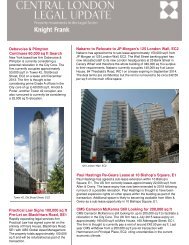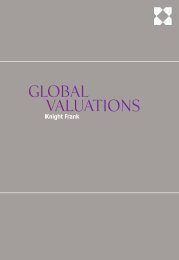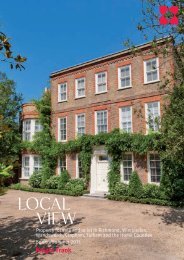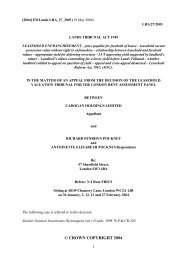40 Chelsea Square - Knight Frank
40 Chelsea Square - Knight Frank
40 Chelsea Square - Knight Frank
Create successful ePaper yourself
Turn your PDF publications into a flip-book with our unique Google optimized e-Paper software.
obtained from the less secure investment but his takes no account of capital growth or loss. DB<br />
41 shows total yields from equities trailing conventional gilts, but PCL yields exceed those<br />
from equities. We think that the deferment rate of 4½% to which Messrs Cullum, Clark and<br />
Gibbs have all spoken makes a sufficient differential for a reversion in a high value house on<br />
the Cadogan Estate as compared with index-linked gilts. We will apply that norm by reference<br />
to the specific qualities and circumstances of the four properties the subject of the Cadogan<br />
cases in the last section of this part of our decision.<br />
153. We are assisted in testing this conclusion by Mr Gibbs’ exercise in discounted cash flow<br />
in DB61. He first tested his deferment rate of 4½% against conventional gilts. He found that<br />
he could equalise the internal rate of return with an annual nominal rate of return of only 0.28%<br />
against a long term rate of growth of capital values from1986 of 8%. We have said why we are<br />
not prepared to adopt that figure as a reliable forecast of future growth or market expectations<br />
of such growth, and do not rely on that comparison. We prefer to compare that figure with RPI<br />
over the same period, which we have concluded that the market could reasonably expect to<br />
match. Mr Gibbs puts the annualised figure at 2½%. The difference between that figure and<br />
0.28% still leaves room for an allowance for costs and any comparative unattractiveness of an<br />
investment in reversions, and indeed makes the actual figure of 4½% a more reasonable<br />
answer. His further comparison between investment in rack-rented property and his deferment<br />
rate gives support to such modest reliance as we have felt able to place on the significance of<br />
the very low yields achieved or accepted in that market.<br />
154. On the basis of such general rate we will turn to consider more specific factors which<br />
should determine in respect of any property within the same broad location what, if any,<br />
deviation should be made from such norm. The concept of a norm is based on our conclusion<br />
that the risks attached to investment in a freehold reversion on the Cadogan Estate are broadly<br />
similar. It follows that any deviation will arise because of some factor which markedly<br />
increases or reduces the risk as compared with other properties of a quality and value which<br />
prevails across the Estate. In considering further the circumstances of 32 Rosary Gardens we<br />
will address such evidence as we have as to how far locational differences, more marked than<br />
are to be found within the Estate, may affect the appropriate norm.<br />
Specific factors<br />
Differences between types of property<br />
(a) Statutory assumptions<br />
155. In determining the price to be paid for the freehold of a house under the 1967Act, section<br />
9(1A) requires the assumption:-<br />
“(c) .. that the tenant has no liability to carry out any repairs, maintenance or<br />
redecorations under the terms of the tenancy or Part I of the Landlord and Tenant Act<br />
1954”<br />
No such assumption is to be made on collective enfranchisement or lease extension under the<br />
1993 Act. The Tribunal therefore asked the valuers who had given evidence in the Cadogan<br />
36









